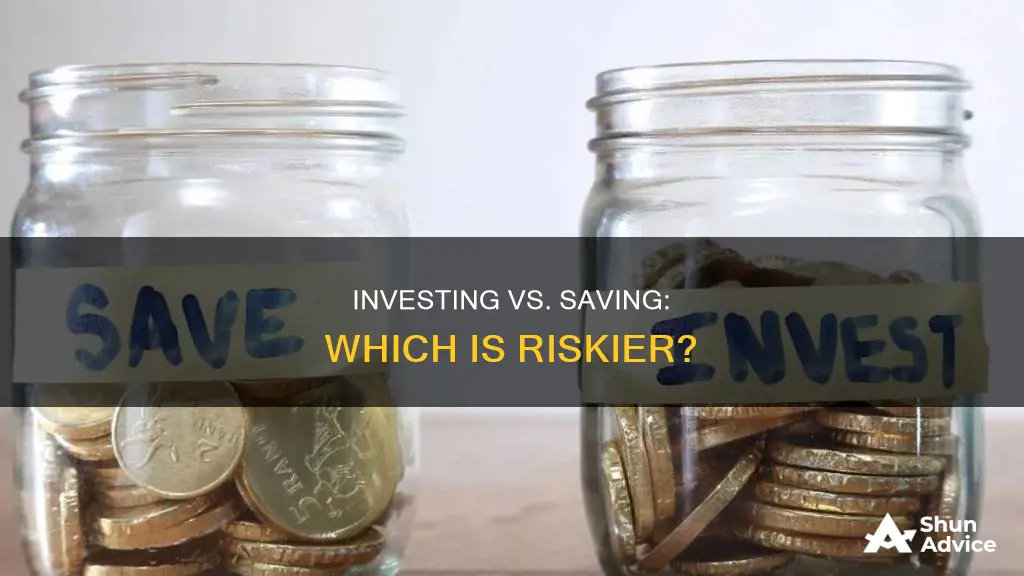
Saving and investing are both important components of a healthy financial plan. While they are often lumped together, they are distinct strategies, each with advantages and disadvantages. Saving is generally considered safer than investing, as it carries little risk and provides a financial safety net. However, investing offers the potential for higher returns and is crucial for achieving long-term financial goals. Understanding the differences between saving and investing is essential for making informed financial decisions and building long-term wealth.
| Characteristics | Values |
|---|---|
| Risk | Saving is safer than investing |
| Returns | Saving has lower returns than investing |
| Time horizon | Saving is better for short-term goals, investing for long-term goals |
| Liquidity | Saving provides more liquidity than investing |
| Complexity | Saving is simpler than investing |
| Inflation risk | Saving may lose purchasing power due to inflation |
| Emergency fund | Saving is recommended for emergency funds |
| Financial goals | Investing is better for achieving financial goals |
| Income generation | Investing can produce a recurring income stream |
| Wealth accumulation | Investing has a higher potential for wealth accumulation |
What You'll Learn

Liquidity and accessibility
Liquidity refers to how quickly you can access your money, and savings accounts are generally more liquid than investments. With a savings account, you can usually access your money at any time without penalty by transferring it from your bank's website or visiting a branch in person.
However, with investment accounts, there may be penalties or taxes, or both, for withdrawing investment gains early. For example, with a certificate of deposit (CD), there is usually a penalty for cashing in early, and you will typically lose some of the interest you have earned.
Money market funds are an exception to this, as they are liquid and you can usually withdraw funds at any time without being penalised.
In terms of accessibility, savings accounts are also generally more accessible than investment accounts. To invest, you usually need to open an account with an independent broker, though some banks now have brokerage arms. Popular online investment brokers include Charles Schwab, Fidelity and Interactive Brokers.
However, it is worth noting that some investments, such as stocks, bonds, and ETFs, can easily be converted into cash on almost any weekday, so they are quite accessible in that sense.
A Safe Investment: Post Office Savings Schemes
You may want to see also

Risk and return
Saving and investing are both important components of a healthy financial plan. However, they are distinct concepts with different levels of risk and potential returns. Understanding the differences between the two is crucial for making informed financial decisions.
Saving
Saving involves setting aside money in a safe and low-risk account, such as a savings account, money market account, or a certificate of deposit (CD). Savings accounts typically offer low returns but are also associated with low risk. They are ideal for short-term financial goals, such as building an emergency fund or saving for a vacation. Saving provides a financial safety net and is an excellent way to meet short-term goals and prepare for unexpected expenses. The main advantage of saving is the minimal risk of losing money, as savings accounts are FDIC-insured. However, one of the drawbacks is the potential loss of purchasing power due to rising inflation, which can erode the value of savings over time.
Investing
Investing, on the other hand, involves taking on more risk with the potential for higher returns. It is a way to grow your money over time by putting it into various financial instruments, such as stocks, bonds, mutual funds, or real estate. Investing is typically associated with longer-term financial goals, such as saving for retirement, a down payment on a house, or a child's college fund. One of the benefits of investing is the potential for higher returns compared to savings accounts. Additionally, investing allows individuals to achieve long-term financial goals and grow their wealth over time. However, investing also comes with the risk of losing money, and there are no guarantees of making a profit. The value of investments can fluctuate, and individuals may not get back their initial investment.
Key Differences
The main difference between saving and investing lies in the level of risk and potential returns. Saving offers a low-risk way to accumulate money with minimal chances of loss but also lower returns. In contrast, investing offers the potential for higher returns but comes with the risk of losing some or all of the invested capital. Saving is generally recommended for short-term goals, while investing is more suitable for long-term goals.
Balancing Risk and Return
When deciding between saving and investing, it is essential to consider your financial goals, time horizon, and risk tolerance. If you need money in the near future or have short-term goals, saving is usually the better option. On the other hand, if you are planning for long-term goals and are comfortable with taking on more risk, investing may be more appropriate. It is also crucial to have an emergency fund and manage any high-interest debt before investing.
In conclusion, both saving and investing play important roles in financial planning. Saving provides a safe and accessible way to accumulate money for short-term goals, while investing offers the potential for higher returns over the long term. The key lies in understanding the differences between the two and balancing them according to your financial situation, goals, and risk tolerance.
Tracking Savings and Investments: Quicken's Smart Money Management
You may want to see also

Short-term vs long-term goals
Short-term and long-term goals require different approaches to budgeting and saving. Short-term goals are those that you expect to achieve within a few months or years, while long-term goals are usually big-picture items that may take several years or decades to achieve.
Short-term goals generally have more specific deadlines and involve smaller amounts of money. Examples include paying off credit card debt, minor repairs and home improvements, or saving for a vacation. To save for short-term goals, consider finding a high-yield savings account, automating your savings, or cutting back on expenses.
Long-term goals, on the other hand, may not be as specific, and the timeline may be more flexible. However, it's important to regularly revisit these goals as life changes can impact them. Examples of long-term goals include paying off a mortgage, starting a business, or saving for a child's college tuition.
Methods for saving for long-term goals include investing in a retirement account, such as an IRA or 401(k), and exploring passive income options. It's also important to have a mix of short-term and long-term savings goals and to not neglect having an emergency fund.
- Know your income and expenses: Determine how much money you can spend and save each month based on your income and expenses.
- Set clear and attainable goals: Whether short-term or long-term, make sure your goals are specific and attainable. For short-term goals, plan ahead to avoid scrambling to make up for sudden expenses.
- Create a savings plan: Work out a realistic savings plan to achieve your goal on time. This might involve setting aside a certain amount of your income each month or putting money into savings with each paycheck.
- Automate your savings: Take advantage of automatic savings features offered by many mobile banking and third-party fintech apps. These can help you save consistently without having to remember to do so manually.
- Cut back on expenses: Look for areas in your budget where you can temporarily reduce spending. For example, cooking at home instead of eating out can help save money in the short term.
- Choose the right accounts: For short-term goals, consider high-yield savings accounts or money market accounts that offer easy access to your funds. For long-term goals, consider retirement accounts or separate accounts for specific goals, such as a college fund for your child.
- Regularly review your progress: Both short-term and long-term goals require regular review to ensure you're on track. A budget can help you stay focused on your goals and keep your savings and spending priorities in check.
In summary, short-term and long-term goals require different savings strategies, and it's important to balance both to ensure financial security and achieve your goals.
Equity Saving Schemes: A Guide to Investing Wisely
You may want to see also

Emergency funds
A good rule of thumb for emergency savings is to have enough to cover three to six months' worth of living expenses. However, the specific amount depends on your financial situation. For example, if you're single with no dependents, three months' worth of savings might be sufficient. On the other hand, if you have a family, a mortgage, or job instability, you might want to aim for six months or more.
Where Should You Keep Your Emergency Savings?
It's generally recommended to keep your emergency funds in a savings account that offers a high interest rate and easy access. Separating your emergency savings from your daily spending money can help ensure you don't dip into your reserves unnecessarily.
High-yield savings accounts are an excellent option as they provide a higher interest rate than traditional savings accounts, allowing your money to grow while remaining accessible. Money market accounts are another alternative, typically offered by banks and credit unions, with a slightly higher minimum balance and limited withdrawals.
Certificates of Deposit (CDs) offer even higher interest rates but come with a catch. Withdrawing money from a CD before it matures usually incurs a penalty, making it less ideal for emergency funds. However, some banks offer no-penalty CDs, providing more liquidity.
How to Build Your Emergency Fund
- Set a monthly savings goal and focus on achieving smaller, attainable milestones.
- Automate your savings by setting up direct deposits or payroll deductions that go directly into your savings account.
- Use mobile apps or savings accounts that round up your purchases to the nearest dollar and transfer the difference to your savings.
- Save your tax refund or adjust your deductions to have less money withheld, allowing you to boost your emergency fund.
- Regularly assess and adjust your contributions as needed.
When to Invest Your Emergency Funds
While keeping your emergency funds in a savings account ensures easy access and liquidity, you might consider investing a portion of it to earn higher returns. Here are some options for investing your emergency funds:
- Money market accounts: These accounts are a mix between checking and savings accounts, usually offering APYs of 3% to 4%. They are considered low-risk and are often insured by the FDIC or NCUA up to $250,000 per account.
- High-yield savings accounts: These accounts, often offered by online banks, provide higher interest rates than traditional savings accounts, typically ranging from 3% to 4%. Your money is easily accessible through online transfers, wire transfers, or check requests.
- Certificates of Deposit (CDs): CDs offer higher interest rates, especially for longer maturities, but withdrawing funds before maturity usually incurs a penalty. Creating a CD ladder or opting for no-penalty CDs can improve liquidity.
Remember, the primary goal of an emergency fund is accessibility and liquidity. While investing a portion of your emergency fund can be considered, avoid investing it entirely in volatile assets like stocks, as you might be forced to sell at a loss during an emergency.
Insurance and Other Considerations
In addition to your emergency fund, having adequate insurance coverage can provide further financial protection. Disability insurance and health insurance are essential, especially if you lose your job and, consequently, your employer-provided health coverage.
When facing an emergency, borrowing money or using credit cards can be options of last resort, but proceed with caution. Borrowing at high-interest rates or adding to existing debt can create a snowball effect, making it challenging to get out of debt.
Planning ahead and building your emergency fund over time will give you peace of mind and help you navigate unexpected financial challenges.
Maximizing Small Savings: Smart Strategies for Investing Wisely
You may want to see also

Inflation
To combat the effects of inflation, investors can consider various financial instruments. These include money market or high-yield savings accounts, which offer returns that may be higher than the inflation rate. Treasury Inflation-Protected Securities (TIPS) and government I bonds are also options, as they adjust their interest payouts based on changes in the Consumer Price Index (CPI), a measure of inflation.
Additionally, investing in stocks, precious metals, or certain commodities such as oil, agricultural goods, and other precious metals can potentially keep pace with inflation better than fixed-return options. These commodities are often used as a hedge against inflation, as their rise in price can help maintain purchasing power.
It is worth noting that there is no sure way to protect savings from the effects of inflation. However, cash savings accounts are generally not the best long-term option, as the interest is usually lower than the inflation rate, leading to a reduction in buying power.
When deciding whether to save or invest, it is crucial to consider the time horizon of your financial goals. For short-term goals, it is generally safer to opt for a savings account without worrying too much about inflation. In contrast, for long-term goals, it is essential to consider inflation when investing.
Maximizing Your Savings Account: A Guide to Smart Investing
You may want to see also
Frequently asked questions
Saving is for preserving your money, while investing is for growing it. Saving typically results in lower returns but with virtually no risk. In contrast, investing allows for higher returns, but you take on the risk of loss.
The pros of saving include a financial safety net for unexpected events, liquidity for purchases and other short-term goals, and a low risk of loss. The cons include missing out on potential higher returns from riskier investments and losing purchasing power due to inflation.
The pros of investing include the potential for higher returns, the ability to grow your wealth over time, and the opportunity to achieve long-term financial goals. The cons of investing include the risk of losing money, the need for discipline and a long-term perspective, and potentially higher fees.
Saving is generally better for short-term financial goals, such as building an emergency fund or saving for a vacation or a down payment on a house. Investing is generally better for long-term financial goals, such as retirement, building generational wealth, or generating income.







